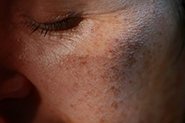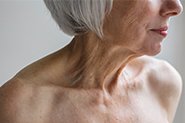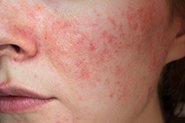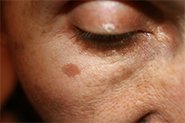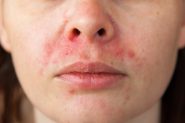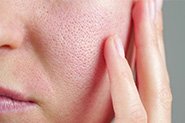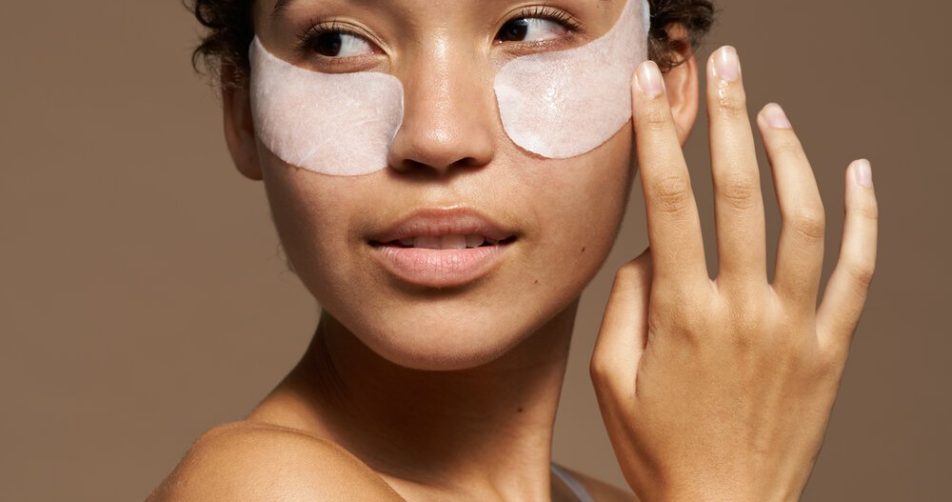
What happens to skin in winter?
One of the primary jobs of your skin barrier (aka the ‘stratum corneum’) is to regulate water loss from the skin to the atmosphere. A healthy skin barrier consists of a finely-tuned balance of microbes, and cells, proteins and the epidermal lipids that ‘glue’ these together.
When this architecture becomes disrupted (driven by reduced humidity, and exacerbated by using too many harsh skin actives or physical exfoliating devices, cold winds, indoor heating/fires and long hot showers/baths, and less sebum production in winter), skin barrier function is reduced: trans-epidermal water loss (TEWL) increases, inflammatory chemicals are produced and the skin becomes more fragile and dehydrated.
As well as feeling uncomfortable and possibly irritated, red and itchy, dehydrated skin looks dry and dull, and lines, wrinkles and pores become accentuated. Flaking skin can also happen, as skin cells flake off without the lipids that normally hold them in place.
Irritant contact dermatitis is also more prevalent during colder, drier weather.
What skincare can help dull, dry winter skin?
Because dehydrated skin results from a disrupted skin barrier, the very LAST thing it needs is exfoliation! Glowy winter skin is the result a healthy skin barrier – and that comes from gentle treatment and moisturiser, not continued assault. This is like suggesting someone use steel-wool to fix damaged, fragile skin!
This is the time to explore gentle cleansers, reducing your cleansing overall (do you really need that double cleanse, or morning cleanse?), heavier, fragrance-free moisturisers, hydrating serums and masks. Reduce exfoliation to weekly (if at all), and think about changing to gentle leave-on exfoliants (very low strength glycolic or salicylic acids, lactic acid for super hydration, or the newer gluconolactone/lactobionic acids).
Even those with oily skin and acne will benefit from moisturiser, as acne-targeting ingredients and formulations are often drying on the skin.
Adding a low-molecular weight collagen peptide or hyaluronic acid supplement (we recommend Vida Glow Hyaluronic Complex) can also help skin’s hydration levels.
And don’t forget sunscreen – in most parts of Australia the UV index remains high enough to require sun protection all year round!
Our top skincare recommendations to get (and keep) a winter glow:
Our go-to products for managing winter skin are:
1. An oil cleanser – especially one that rinses clean so there’s no need for a second cleanse (bonus: oil cleansers are better than other cleanser types for removing sunscreen, even with only a single cleanse!)
2. Thicker, fragrance-free, glycerin-rich moisturiser for overnight – applied on damp skin
3. Vaseline – useful as lip balm, to soothe dry, sore, flaky spots or as an all-over night-time moisturiser (no, it’s not comedogenic!)
If you really suffer with winter skin woes, a humidifier in your bedroom or office can make a huge difference!
What if I have an existing skin condition?
For those with pre-existing dry skin conditions like eczema/atopic dermatitis, dry, cold air presents a particular challenge. Check in with your doctor and get a prevention plan in place before winter really kicks in.
Prescription retinoid users, even those who have been using retinoids for some time, may also experience increased irritation and dryness during this period. If you are a Qr8 MediSkin patient, this is easy to manage – just contact our Skincare Support Team for 1:1 help and personalised product recommendations! Don’t stop your treatment though – you will just have to go through the skin adjustment stage again when you re-start.
What about body skin? It gets dry too!
The same advice also applies for body skin (especially hands) – treat it gently and nourish with an oil cleanser, pat (not rub) dry, use a heavier, fragrance-free moisturiser on still-damp skin, and pop some Vaseline on the driest parts.
WINTER IS A GREAT TIME TO GET STARTED WITH PRESCRIPTION RETINOID TREATMENT.
CLICK HERE TO BOOK A CONSULT WITH OUR EXPERIENCED MEDICAL TEAM.
REFERENCES
- Bouwstra JA, Ponec M. The skin barrier in healthy and diseased state. Biochim Biophys Acta. 2006 Dec;1758(12):2080-95. doi: 10.1016/j.bbamem.2006.06.021. Epub 2006 Jul 11. PMID: 16945325.
- Elias PM. Skin barrier function. Curr Allergy Asthma Rep. 2008 Jul;8(4):299-305. doi: 10.1007/s11882-008-0048-0. PMID: 18606081; PMCID: PMC2843412.
- Engebretsen KA, Johansen JD, Kezic S, Linneberg A, Thyssen JP. The effect of environmental humidity and temperature on skin barrier function and dermatitis. J Eur Acad Dermatol Venereol. 2016 Feb;30(2):223-49. doi: 10.1111/jdv.13301. Epub 2015 Oct 8. PMID: 26449379.
- Schwartz J, Friedman AJ. Exogenous Factors in Skin Barrier Repair. J Drugs Dermatol. 2016 Nov 1;15(11):1289-1294. PMID: 28095538.


